How I Made $2,236 on a Friday Afternoon Selling WAY Too Soon: Key Takeaways
- This late-day strategy works so well, sometimes I don’t even hold overnight.
- Nothing in trading is 100%, but this is the best way I know to grow an account under the PDT rule without using a day trade.
- You don’t have to trade crypto or forex to make weekends work for you.
FREE Webinar Reveals the Strange Market Phenomenon Most Traders Don’t Know About
Table of Contents
Why I’m Happy About a $14,648 Trading Mistake
Shoulda, coulda, woulda…
It was Friday, May 21, 2021. Like most traders, I was ready for the weekend.
Even though May was slow, I’d already made $23.5K for the month. That seems like a lot until you put things in perspective. In the first four months of 2021, I made $829,335.* The pace was grueling.
So May was slow and it had been a slow week. I’m pretty sure it was my worst profit week in over a year. Putting it bluntly, I was ready to call it a week when I got an alert about this tweet…
After 20 years in the trading game, I knew this could be big. I did a quick search and found this…
Finally, just to be sure, I clicked the news link in the tweet and quickly scanned the press release. Here’s what I saw at the top…
That’s when I realized…
MJWL Fit One of My Favorite Strategies to a T
But time was of the essence…
The press release had hit the wires an hour earlier…
The Seeking Alpha article had been out for 20 minutes…
… and the company tweet had been out for five minutes.
I knew I had to act fast. I immediately tried to load up on shares. I only got a partial fill. My position of 385,500 shares was a small (for me) investment of $11,179.50.
I posted this on Profit.ly…
“Company tweeted saying news next week so it’s an upcoming news play into the close on a Friday, goal is to profit 10-20%, goal is to sell in the .03s today or Monday.”
Two minutes later it was up 5%. After five minutes it had spiked 13%. When I exited my position after just 12 minutes it was up 20% for a $2,236 win.*
In my exit comments, I wrote…
“Tried to have patience, but this has already achieved all my goals so no need for any overnight risk in a slower trading environment…whew, nice way to end the week for me with my best trade of the week!”
The Crazy Thing Is, I Completely Underestimated It!
I’ll explain, but first here’s the MJWL chart from May 21 with my trade…
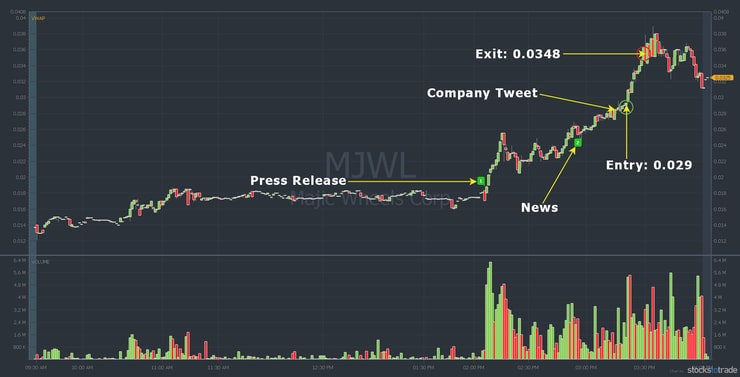
I was happy with that trade. Even though I hadn’t traded badly during the week, there just weren’t that many plays in OTC land. And I was traveling, too.
Some students asked how I knew MJWL would keep spiking since the news was already out. It’s a valid question.
One of the reasons I love penny stocks is because of what I like to call informational inefficiency. (I’ll explain more in the free webinar on Wednesday, September 1. Keep reading for details.) But that alone wasn’t enough for me to take the trade.
Thing is, if you know what information to look for, and where to find it…
More Breaking News
- First Solar’s Unexpected Leap: Time to Reassess?
- BMNR Unexpected Surge: Exploring Recent Developments
- Momentus Inc. Facing a Critical Trend Shift?
It’s Like Having An Information Edge
I’ll come back to that because it might just be the most important part of this strategy.
The informational inefficiency often happens on a Friday afternoon. Which brings up another question many students asked…
Why didn’t I hold MJWL over the weekend?
The main reason was because it had already reached my goals. (Always trade with a plan.) So there wasn’t any need to hold. Also, at the time, a lot of spikers were failing on day two. So I was adapting to the market. And again, I was traveling.
If it hadn’t met my goals — say I was break even — I probably would’ve held. And if the market was still hot like January and February? I probably would’ve held. I even might’ve held it over the weekend if I wasn’t traveling.
More students asked this question…
“Tim, how did you know it would spike more based on a tweet?”
Nothing in trading is sure. But there was one sentence in that tweet that made it fit my strategy to a T. More about that later.
In the end, I sold too soon. But had I held it would have been an AMAZING trade. This is where the trade gets very interesting…
Shoulda, Coulda, Woulda
Even though MJWL didn’t close strong, it gapped up 25% that Monday. And then it just kept going. So if I’d held it and sold at the open, my profits would have been $3,932…
And if I’d had the patience to hold for 10 minutes (yes, just 10 minutes) after the market opened … my profits would have been $10,716.
Wait, it gets crazier. Had I held for 58 minutes … less than an hour … my original $11,179 would be worth $28,064 for a profit of $16,884…
THAT is how much I underestimated it. But I was happy, anyway. Why? Because it meant one of my all-time favorite strategies was in play.
Quick aside here … I traded MJWL twice in the first hour of trading on May 24 based on the strong price action. One trade was a $1,910 win and the other was a $2,484 win. So I still took advantage of the opportunity — just not the full potential.
The important thing to remember is that all three trades came from the same strategy.
It’s the very same strategy that helped me make $123K over the weekend, from my dorm room, while still in college. And it’s the same strategy that I used to make $69,962 from a yacht while filming “Below Deck” with a group of students.*
So, how did I know? Keep reading because I’m going to show you exactly how I did it. And how I often enjoy weekends while making killer money without having to sit in front of my laptop trading crypto or forex.*
More Than Pattern and Price Action
Keep in mind that just because it looks like the right pattern, that doesn’t mean it fits the strategy. Sometimes stocks gap up over the weekend even when my indicators don’t align. So the pattern plays out, but the odds are lower. I tend to avoid a trade like that unless all my indicators line up.
A good example is INVU on March 26–29, 2021. I was giving a live Trading Mastery webinar on Friday, March 23, when INVU suddenly spiked around 3:05 p.m. Eastern. Some students familiar with my strategy asked why I wasn’t taking the trade.
Simple — all the indicators weren’t there. One thing, in particular, was off. That’s why it’s so important to understand the nuances of the strategy. It’s not easy to learn and requires study. But as they say, the devil’s in the details.
Here’s the chart. The yellow circle shows where it happened…
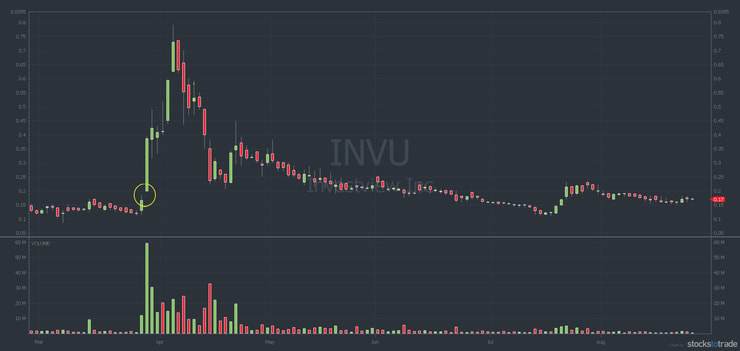
Thanks mostly to promoter hype, INVU did gap up over that weekend. But the odds just weren’t there for me on Friday. And I don’t regret missing the trade.
Again, this is why you have to learn the entire strategy and not just the pattern. Looking at the chart in hindsight it seems like a no-brainer, right? But what if the promoters pulled the plug? At the time, there were promoters suddenly deleting Twitter accounts. The SEC was even alerting investors about fraudulent stock promotions. So it was a no-go for me — too much risk.
Fridays Are Special, But It Can Happen Any Day
One thing to know is that while I love to use this strategy over the weekend, it also plays out during the week. The main difference is important — and I’ll explain it all during the webinar. But to show you what I mean, check this out…
On August 19, I received an alert about this news…
The alert came in the morning, even before the market opened. Usually, I like this strategy better if the news hits on a Friday afternoon. But, again, there are multiple indicators. I watch seven indicators on every trade. In this case, the news created enough buzz for me to trade a variation of the strategy…
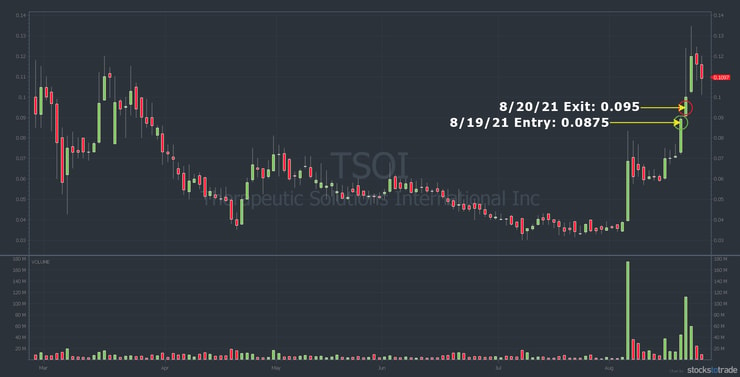
It wasn’t a huge trade — only $641 in profits.* But it shows the strategy works even during a tough August market. And, as long as the indicators line up, it doesn’t necessarily have to be a Friday.
Here’s another example to show you it’s not just me…
Matt Monaco’s Perspective Shift
Back in March, one of my millionaire students, Matt Monaco, used this very same strategy to profit over the weekend. On Friday, March 12, he got an alert about this news…
As Matt tells it…
“I learned your strategy and can tell you it definitely changed my perspective on weekends. I opened this AABB trade on Friday, enjoyed my weekend, and closed it out on Monday for $35,141 in profits!”**
Here’s the chart…
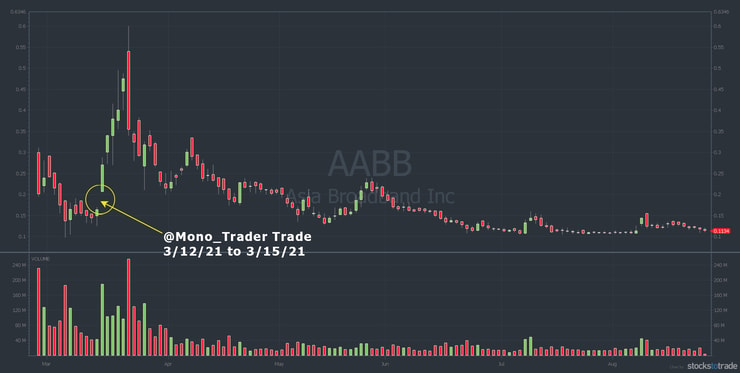
One thing to know about this trade by Matt is that he was trading big size. Which usually means sizing in and out. He also had a big starting stake of $264,500. But understand that the strategy can work for small accounts, too.
Actually, I think it’s the best strategy for anyone under the PDT rule. Why? Because you don’t have to waste a day trade on it.
Here’s one final recent example. And it shows why this is…
My Favorite Strategy for Small Accounts
Anyone with knowledge of the strategy could do this trade. Even those under the PDT. On August 13, this headline popped up in my alerts…
As you can see, the news hit in the morning again. It’s not an exact science. But everything lined up that day. So about 15 minutes before the close, I bought shares.
The overall market was weak to start the next Monday. So the trade wasn’t a huge win — only $450 in profit.* Crucially, had I held at the open, this one would’ve turned into a loss.
Check out the chart…
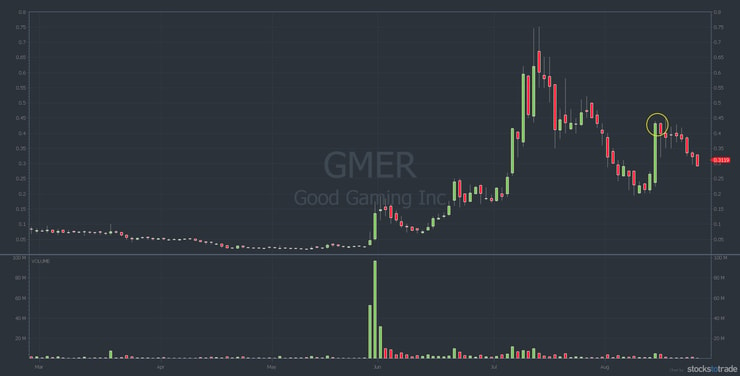
That’s another reason you MUST understand the nuances. This isn’t just a ‘buy any old spiker late in the day’ play. You also have to know how, and when, to exit.
And THAT is why I’m giving a free webinar next Wednesday, September 1. During the webinar, I’ll show you…
- More examples of how this pattern works. (And why you MUST know when to open and close the trade.)
- How this strategy is based on a little-known market anomaly. (One economist even won a Nobel prize…)
- And why some news, at the right time, is far superior to other news.
Plus, I’ll show you how I’ve used this very same strategy to make $8,780, $9,518, and even $16,159 on weekends.*
There is NO COST to attend this webinar, but it’s on a first-come, first-served basis. If you don’t sign up, you could be left out.
**Join Me for My Upcoming Weekend Profits Webinar**
Disclaimers
*Results are not typical and will vary from person to person. Making money trading stocks takes time, dedication, and hard work. Most who receive free or paid content will make little or no money because they will not apply the skills being taught. Any results displayed are exceptional. We do not guarantee any outcome regarding your earnings or income as the factors that impact such results are numerous and uncontrollable.
**Matt’s starting stake on this trade was $264,500.

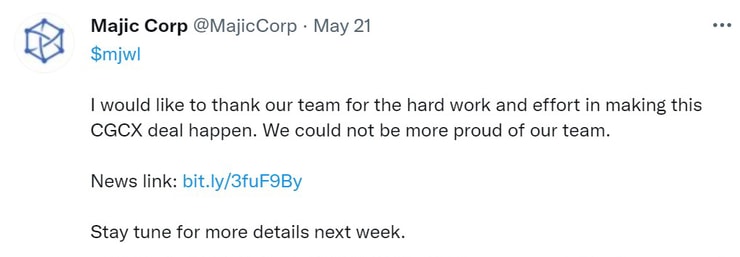
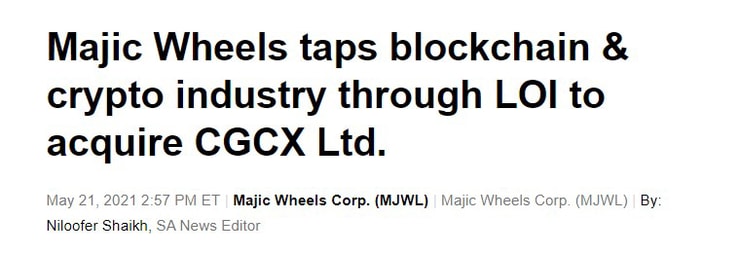





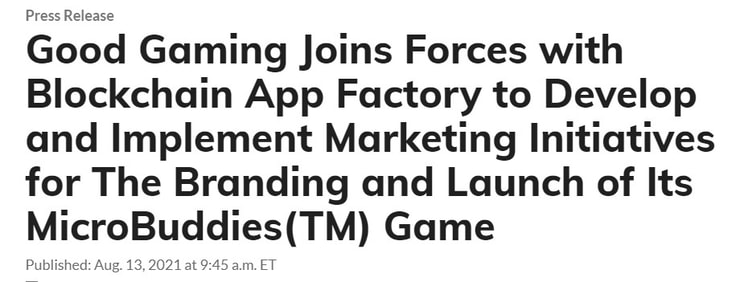







Leave a reply